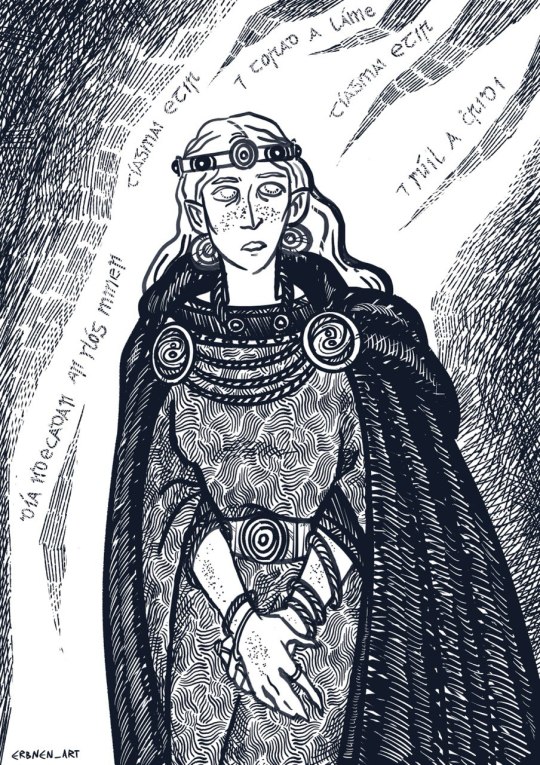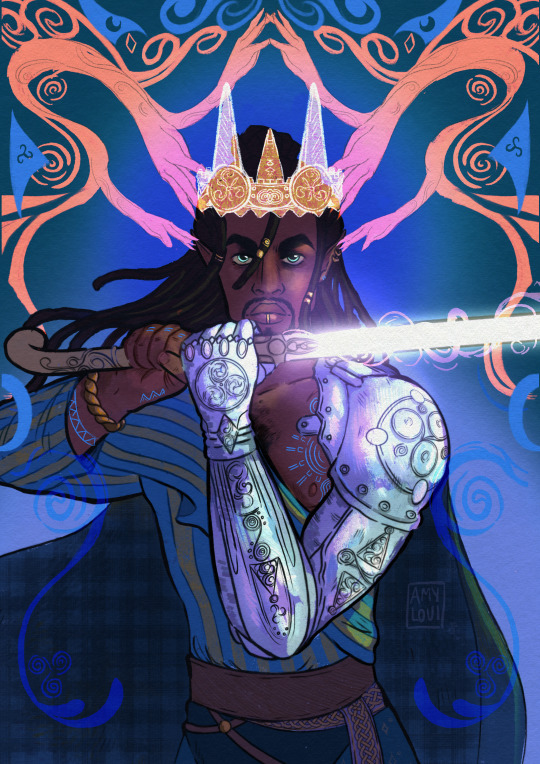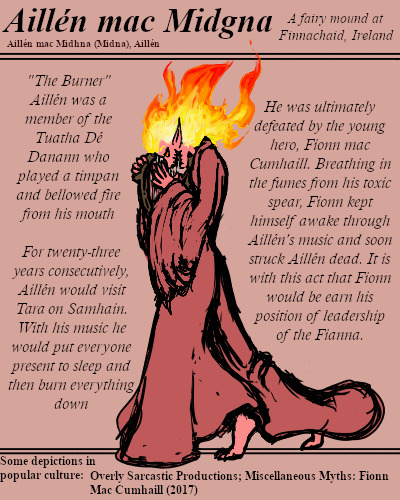#tuatha de danann
Text

A commission of Brigid for @bloodtreachery (awww, it was SUCH a pleasure to do it!). I put an emphasis on her aspect as a poet, hence the fire of poetry ablaze!
The poem in the flames is a liberal translation of these lines from The Hosting of the Sidhe into Old Irish (courtesy of my wonderful husband):
...if any gaze on our rushing band,
We come between him and the deed of his hand,
We come between him and the hope of his heart.
#artists on tumblr#irish mythology#brighid#brigid#celtic paganism#gaelpol#paganblr#pagan art#illustration#commission#commissions open#tuatha de danann#irish goddesses#goddess brigid#druidism#celtic deities#aodhan erbnen
326 notes
·
View notes
Text

The Riders of the Sidhe (detail) by John Duncan, 1911.
Sidhe or else the Tuatha Dé Danann, mystical or fairy people of the Irish mythology and folklore.
#john duncan#mythology#celtic#irish#sidhe#tuatha de danann#fairy people#painting#folklore#world traditions#mysticism#symbolism#art
164 notes
·
View notes
Text

July Postcard, Nuada Airgetlám
King of the Tuatha Dé Danann, husband to Boann, Bres-enabler, Lugh-predecessor and owner of Fragarach, a very cool sword.
If you'd like a postcard, sign-up before the end of the month!
#artists on tumblr#irish mythology#nuada#tuatha de danann#celtic mythology#irish myths#fantasy illustration#original illustration#illustration#my art
295 notes
·
View notes
Text

I tried to be semi-serious about it, I really did… but the only thing I could think the entire time was “he looks like he gets good reception”
#lugh#lugh lamhfada#lugh samildanach#Celtic paganism#Irish paganism#Celtic mythology#Irish mythology#tuatha de danann#art#sketch#digital art#doodles
110 notes
·
View notes
Text
I've been looking more into the myths and legends that inspired Tolkien, specifically into Irish Mythology, and there are actually a lot of very interesting similarities, particularly in Tir na nÓg and the Tuatha dé Danann.
Tir na nÓg means 'the land of the young', and is an enchanted isle off the west coast of Ireland where all were happy and suffered no illness or unhappiness. It is also called the Otherworld, and just like with Valinor, was often mistaken for a kind of heaven or afterlife when it was an actual, earthly place that could be reached by sailing across the sea(or through magic).
It was from Tir na nÓg that the Tuath Dé came, sailing eastwards in a fleet of 300 ships. Tuatha dé Danann means "people of the Goddess Danu". The Tuath Dé are immortal beings who are immune to aging and illness who came from across the sea and inhabited the lands of Ireland before Men ever came there.
Upon landing on Ireland's shores the Tuath dé immediately took the ships they had used and burned them to prevent anyone from returning to their homeland. The smoke from the fires could be seen for miles and the dark cloud lasted for three days straight.
In their first battle against their enemies and former inhabitants of Ireland the Formorians, the King of the Tuath Dé, Nuada, had his arm sliced clean off. Because he was no longer "unblemished", he thus lost his kingship, although a new hand was made for him that was made of silver. Nuada thus gained the epithet of Airgetlam, meaning 'silver hand/arm'.
They were powerful magic users, and during the years they spent there conquered most of Ireland, though at the cost of much blood.
But just like the Elves, so do the Tuath Dé and their power eventually fade at the coming of Men, the Milesians, the ancestors of the Irish people. In some tales the Tuath dé fight back and are driven underground by the Milesians, but in others versions the Tuath Dé foresee and accept their fate, and flee beneath the earth where they later become the sidhe, the fairy folk, or Little People, living in barrows and cairns. In other versions, the Goddess Danu sent many of the Tuath Dé to live in Tir na nÓg, and made homes beneath the earth for those who wished to stay.
Overall, very alike to Tolkien's Elves, specifically the Noldor!
#there's also Failinis who was an enormous magical hound#who was practically invincible and could slay any creature it came across#sounds very much like a certain hound of valinor...#silmarillion#Tolkien#Irish myth#tuatha de danann#tir na nog#Noldor#Valinor
149 notes
·
View notes
Text

Maiden Mother Crone
Edited for accuracy:
From information in the book by JAMES MACKILLOP - DICTIONARY OF CELTIC MYTHOLOGY
The Morrigan is associated with fate and fortune and a triplicate that represents change, from maiden to mother to crone. The Morrigan embodied many forms of change such as shapeshifting into creatures, not only different age variants of a human woman.
Pages 335-336:
She can be a "beautiful young woman," a "hag," and is a mother to "Mechi."
"She is part of a trio of war goddesses called the Morrigna, with Badb and Macha."
"Nemain may sometimes be part of the three."
She is "much associated with the crow," and can change into many things, including said crow: "The Morrigan appears on his shoulder as a hooded crow," the "he" here meaning CuChulainn.
As a war goddess she is known to be brutal and bloody, "passing out handfuls of...blood to gaping bystanders," in one famous fight.
My own additional note as the artist:
Change can be illustrated many ways, one of which as the moon changing from waxing to full to waning. This may be part of why the misunderstanding that the Morrigan is a moon-goddess arose, artistic depictions like mine trying to illustrate not a moon-goddess but a change-goddess. This is why the moon's changes are depicted alongside the changes in age of a woman, change in her clothing, triple-changing. An animal changing its coat etc. could illustrate largely the same thing in a different manner. She is NOT a moon goddess in Irish history.
Because the Morrigan is associated with wars and crows, she is often associated with the colors black and red in depictions, said depictions may not be historically accurate to how Irish peoples depicted her in their time.
Some, such as wiccans, pagans, etc., use many different names for the 3 aspects of this triplicate and may associate her with the moon incorrectly. 3 of those names are Danu, Macha, and Badb, and while all three of those names do appear in Irish mythology in different contexts, they are here skewed from historical truth. The source above does say that the Morrigan can be associated with Ana (also known as Anu or Danu), but does not say they are the same individual.
The maiden archetype in many cultures is associated with loveliness, the mother archetype with nurturing, and the crone archetype with wisdom. I wished to depict these three personality traits in my art piece.
Original Post unedited, as I wish to stay accountable and another has corrected me on my vague phrasing that implied things I did not mean:
The Morrigan is a goddess of Fate and Fortune and a triplicate that represents change, from maiden to mother to crone as from waxing to full to waning moon. There is debate about how associated with the moon's phases they are, but it is certain they embodied many forms of change such as shapeshifting into many creatures, not only different age variants of a human woman. Crows are sacred to Her and she is said to wear black or red. They have many names but to some The Lovely Maiden is Danu, the Nurturing Mother is Macha, and the Wise Crone is Badb.
#maiden mother crone#the maiden#macha#tuatha de danann#morrigan#inktober#inktoberday10#inktober fortune#inktoberfortune#druidism#celtic#irish mythology#celtic mythology#european mythology
54 notes
·
View notes
Text
Ode to Brighid
"O Brighid, fair daughter of the Good God,
Smith of shining silver and silvered songs,
The badgers, the snowdrops, they breach the snow:
Winter's crystal mantle, to welcome you,
Goddess! Patron of poets and plowmen alike
Take my prayer, let it be fuel for the flame."

[original composition]
#celtpol#brighid#brig#brigit#brigid#imbolc#saint brigid#prayer#pagan prayer#pagan poetry#tuatha de danann#from the writing desk
154 notes
·
View notes
Text

The fire-breathing Aillén, a wicked musician of the Tuatha dé Danann who was the bane of Tara for 23 years.
#BriefBestiary#bestiary#digital art#fantasy#folklore#legend#myth#mythology#fairy#fae#faerie#tuatha dé danann#tuatha de danann#samhain#aillén#aillén mac midgna#aillén mac midhna#aillén mac midna#the burner#aillén the burner#fionn mac cumhaill#boyhood deeds of fionn mac cumhaill#tara#hill of tara#irish folklore#irish mythology#irish legend#monster
112 notes
·
View notes
Text
The Real Mother of the Gods
Random internet articles will tell you how Danu is the mother of the Irish gods, like some overarching ancestral figure.
When reading the actual lore, this idea is pretty false. There may be a Danand, mother to three gods, but no great Danu. This is even argued, as a better translation may reveal they are three gods of skill, the word for skill confused or made into the name of a goddess.
While I was reading the verse portion of the Lebor Gabála Érenn volume 4 (LGE) on the tuatha, I discovered something interesting. Ethniu is named as mother to seven of the major gods: Luichtaine, Creidne, Goibnu, Dian Cecht, Nuada, Dagda, and Lugh.
Additionally, in the Cath Maige Tuired, if I am not mistaken, Ogma is named as one of her sons.
It is a shame this isn't discussed more. The prose text of the LGE does not mention this either. It mostly recounts who is the father to whom.
Ethniu is daughter of Balor, a Fomorian king. The Fomorians share ancestors with the gods, and live on islands close to Ireland.
Folk or fairy tales tell how Balor heard a prophecy that his grandson would kill him, so he locked Ethniu up, surrounded only by women, until a man looking for a magic cow Balor stole sneaks in and she gets pregnant with Lugh.
In the LGE it is mentioned she is given to Cian, a god, in marriage and they have Lugh.
But turning to the verse texts in the LGE, here is the small passage:
"They were powerful against their firm conflict,
The seven lofty great sons of Ethliu.
Dagda, Dian Cecht, Credne the wright,
Luichne the carpenter, who was an enduring.
consummate plunderer,
Nuada who was the silver-handed,
Lug Mac Cein, Goibninn the smith."
(The names have variations of how they're spelled in the LGE.)
Her first six sons are over different skills/roles, a smith, wright, carpenter, a physician, a king, and a druid/wizard/warrior, but her son Lugh possess all of the skills and becomes the king of the gods after Nuada’s death.
I think Ethniu/Ethliu should get the credit for being mother of the gods.
#irish mythology#tuatha de danann#irish myth#pagan#irish lore#celtic myth#goddess#irish gods#witchblr
34 notes
·
View notes
Text
If I see one more of those cheesy aesthetic witch infographics saying Lugh is a celtic deity and only a celtic deity I'm going to lose my mind, why do you all refuse to say Irish why is specifying so hard
84 notes
·
View notes
Text
An oldie but a goodie.
The passing of the scepter from the Seelie Court to the Unseelie Court

#autistic artist#art#artists on tumblr#artwork#artlr#fae folk#the good folk#seelie court#unseelie#tuatha de danann#fae are angels that are too good for hell but are too naughty for heaven.#reminds me of our#ineffable husbands#😉
38 notes
·
View notes
Text

Manannán mac Lir getting ready to remove someone's head.
#manannan mac lir#orbsen mac allot#tuatha de danann#irish mythology#celtic mythology#celtic paganism#samhain#artists on tumblr#inktober day 26#inktober 2023#inktober#celtober#celtober 2023#irish paganism#my art#irish folklore#aodhan erbnen
257 notes
·
View notes
Note
Who are the anunnaki? Saw a post and someone said the Tuatha De could be Anunnaki...
They. They said wh- pffffffffffffffft-
The Annunaki are literally just a pantheon of gods worshiped in Mesopotamia. Like, they're just another polytheistic pantheon, and their myths have many of the same, for lack of a better term, stock mythological tropes you can find in many, many, many other traditions. I cannot overstate it, the Annunaki are a perfectly normal polytheistic pantheon.
It also happens that the Annunaki are the polytheistic pantheon that the ancient aliens conspiracy theorists fixate upon the most. The reason for this is that the mythological traditions found in Genesis had parallels in older Mesopotamian myths. The conspiracy theorists basically decided that since the Mesopotamian myths were older, they were closer to historical truth, which Judaism and Christianity must have been instituted to hide from us. (Because conspiracy theorists are into all that shit from The Protocols of the Learned Elders of Zion and recycle them into new and more ridiculous forms of crap every day.)
Of course some of these conspiracy theorists believe that other people's divinities must have been the Annunaki under different names or whatever, so you can find people claiming that Enlil and Zeus were the same, Enki and Satan were the same, etc. If you're seeing somebody claim that the Annunaki and the Tuatha De Danann are the same, it's probably another instance of this crap.
#answered#annunaki#gods#deities#conspiracy theories#conspiracy theory#conspiracism#pseudohistory#tuatha de danann#ancient aliens
20 notes
·
View notes
Text

The arrival of Lugh to the court of the Tuatha Dé Danann 💫
(This is my November postcard! If you’d like to be sent one, you can sign up here)
#irish mythology#artists on tumblr#illustration#amylouioc art#celtic mythology#fantasy illustration#lugh#nuada#tuatha de danann#celtic polytheism#praying the fidchell historians don’t kill me#The Coming of Lugh
105 notes
·
View notes
Text
Some say the Milesians are a mythical people while others proclaim they are the ancestors of the Celts. Their story is one rich with intrigue and history. To settle in Ireland, they first had to overcome the supernatural race that occupied the land.
#Milesians#ireland#mythology#Mil#Gaels#Gaedil#Nel#Breogan#Tuatha De Danann#Amergin#celts#ancient#history#ancient origins
65 notes
·
View notes
Text

The Dagda, the first born and powerful chief of the Tuatha dé danann, he’s Married to the goddess the Morrigan. The Dagda is a god of many things, such as: fertility, strength, fatherhood, magic, weather, plant life, druidry, wisdom, life and death. To accentuate his many faceted qualities, his title of ‘the Dagda’ means ‘the good god’ attesting his excellence at all things. He may be the true identity of the god Briain, the first son of Donn and Danu. Briain, underestimating his own strength, killing his father in an attempt to free his other siblings from his parent’s embrace. The Dagda was also a major player in the wars against the Firbolg and the Fomorians. The Dagda’s role however wasn’t as great as his brother’s: Nuada. But when Nuada was injured in battle, the Dagda carried him back to safety.
Like most of the Irish Celtic gods, after christianization, the Dagda’s divinity was stripped away, with Christian writers depicting him as a mere sorcerer. But his popularity endured, those same Christian writers immortalized his myths in written form. The Dagda was also commonly conflated with the Norse Odin, as well as being connected to the Vedic god Varuna.
#art#character design#mythology#celtic#celtic mythology#irish#irish mythology#pagan#the dagda#dagda#briain#chief god#fertility god#wisdom god#life god#death god#plant god#tuatha de danann#strength god
19 notes
·
View notes